It doesn’t seem too long ago that gathering in large groups was a normal part of life, but the COVID-19 pandemic that has swept across the world has made such gatherings feel like a distant memory. In the absence of any significant social gatherings in the near future, take a tour through one from the past – the Century 21 Exposition, also known as the Seattle World’s Fair, which over the course of its run attracted over 10 million people from all over the world to its many exhibits. One such exhibit was sponsored by the American Library Association, who showcased the importance of libraries to a world yearning for innovation.
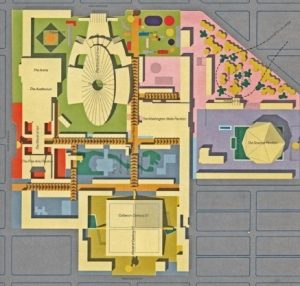
The Exposition, which took place April 21st to October 21st of 1962, was centered around promoting advances in modern science, space exploration, and future societal progressions [1]. All sectors of American society were excited about the possibilities of the Exposition – the publicity opportunities that millions of fairgoers presented enticed companies like Ford Motor Company and Boeing to sponsor exhibits in the World of Commerce and Industry section of the grounds. The United States government, excited at the prospect of exhibiting their prowess at the height of the Cold War, committed $9 million to the Exposition. Most of this commitment went to the construction of the NASA-themed United States Science Exhibit, which is now the Pacific Science Center.
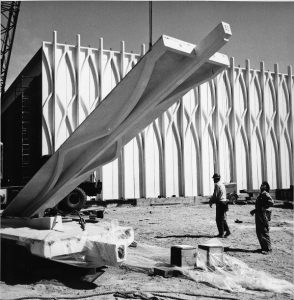
Impressive exhibits need grand architecture to encompass them, and esteemed designer Paul Thiry was hired as chief architect of the Exposition. A major achievement during the construction of the Exposition was the Washington State Pavilion (now the KeyArena), which was the centerpiece of the World of Tomorrow area of the grounds. Thiry was responsible for the creation of an “aesthetically adventurous cityscape intended to excite the visitor with futuristic visions of scientific progress” [1]. The ultimate jewel of the Exhibition was the Space Needle, which remains an iconic architectural achievement to this day.
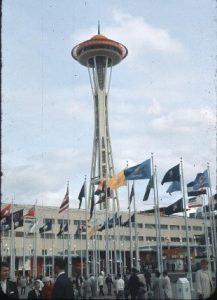
The American Library Association’s presence was made known at the Exposition through their exhibition, named Library 21 – an “automated library of the future” located in the Washington State Coliseum [2]. The ALA, seeing how much impact technology would have on future methods of information access, storage, retrieval, and communication in libraries, designed the 9,000 square foot space to “show how technical change will introduce new dimensions in library programs” [2]. The exhibit space was divided into two sections. One section was dominated by a state-of-the-art Sperry-Rand UNIVAC Solid State 90 computer, which demonstrated how computation systems could expand and simplify the learning process [4]. Visitors could submit queries to onsite librarians, who would find the answers using the UNIVAC machine.
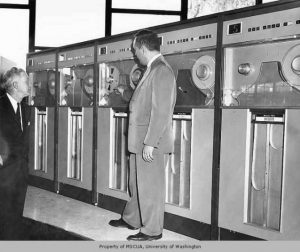
The other section included a 40-seat theatre, sponsored by Xerox, that showed the history of recorded knowledge on microfilm through multiple projection techniques [3]. Other components of the Library 21 exhibit included [2 & 4]:
- “Ready Reference” stations staffed by on-site librarians and stocked with a Xerox 914 copier (sponsored by Encyclopedia Britannica)
- an Adult Reading Area (sponsored by Great Books of the Western World of Encyclopedia Britannica)
- Micro Image Library of the Future (sponsored by National Cash Register)
- RCA Video Library
- Learning Resources Center (sponsored by U.S. Office of Education)
- Children’s World, which housed 2,000 children’s books from around the world
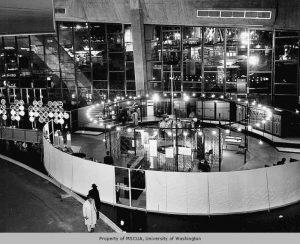
The Exposition designated October 2nd as “Library Day” to honor the work of librarians and highlight the important role libraries have played throughout history and the continued role they will play in the future.
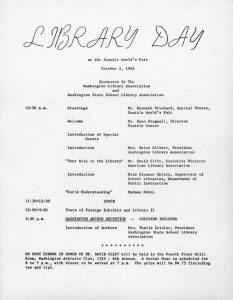
The Century 21 Exhibition was hailed as a success, greatly surpassing its projected attendance. Visitors from around the world experienced cutting-edge technologies and expanded their worldviews, and guests at Library 21 learned about the vital importance of librarians and the services they provide. By showcasing the changes to come in information technology, the ALA showed that libraries can adapt to any challenge put in front of them. The advancements touted in the Library 21 exhibit, and the importance of those advancements to the furthering of librarianship, could mirror the impending changes to library systems in a post-pandemic world.
More information on the ALA’s involvement in the Century 21 Exhibition can be found at the American Library Association Archives, Record Series 2/4/66, Boxes 1-6.
[1] “Century 21 World’s Fair”, Seattle.gov, https://www.seattle.gov/cityarchives/exhibits-and-education/digital-document-libraries/century-21-worlds-fair.
[2] Brochure, 1962. Library 21, Record Series 2/4/66, Box 2. American Library Association Archives.
[3] Century 21 Exposition, 1962. Official Guide Book, Seattle World’s Fair 1962. Seattle: Acme Publications, p. 35.
[4] “1962”, American Library Association, February 27, 2013. http://www.ala.org/aboutala/1962